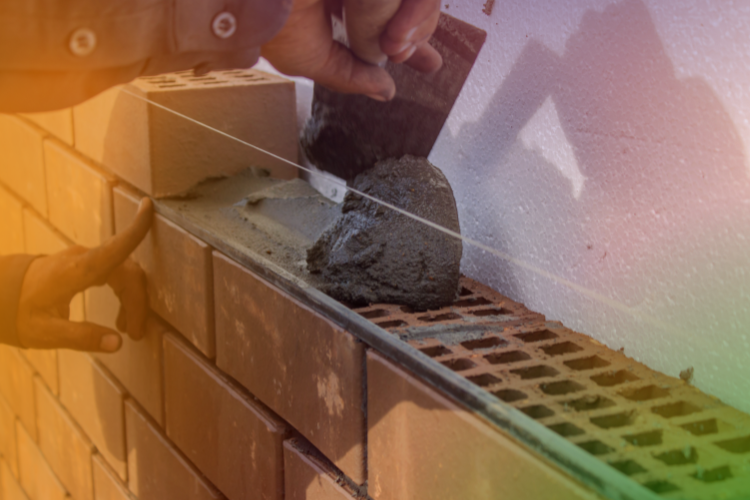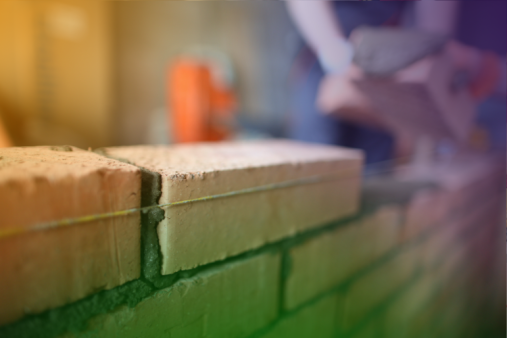Bricklaying is a fundamental aspect of construction that combines skill, precision, and a deep understanding of materials and techniques. Whether you are a seasoned professional, a DIY enthusiast, or simply curious about the trade, getting to grips with the terminology can greatly enhance your appreciation and competence in the field.
Our comprehensive A-Z bricklaying glossary offers clear and concise descriptions of over 100 essential terms. This guide will equip you with the knowledge needed to navigate bricklaying projects with confidence, ensuring you understand every step of the process from admix to zoning. Dive into our glossary to build a solid foundation in the art and science of bricklaying.
A
- Admixture: Chemicals added to mortar or concrete to modify its properties, such as setting time or workability.
- Aggregate: Sand, gravel, or crushed stone added to cement and water to make concrete or mortar.
- Anchor Bolt: A bolt embedded in concrete to hold structural elements in place.
- Angle Grinder: A handheld power tool used for cutting, grinding, and polishing bricks and other materials.
- Arch: A curved structure spanning an opening, used for support and decoration in brickwork.
B
- Batten: A strip of wood used to guide the laying of bricks to ensure they are level.
- Bed Joint: The horizontal mortar joint between two courses of bricks.
- Bond: The pattern in which bricks are laid, ensuring stability and strength in the wall.
- Brick Trowel: A hand tool with a flat, pointed blade used for spreading mortar.
- Brick Veneer: A single layer of brickwork used for aesthetic purposes, often attached to a structural wall.
- Bricks: Rectangular blocks made of clay or concrete, used in building walls and structures.
- Bullnose Brick: A brick with rounded edges, often used for decorative purposes or to soften the look of a corner.
- Butter: To apply mortar to a brick before laying it.
C
- Cavity Wall: A wall consisting of two layers (or "skins") of brick with a gap (cavity) between them, improving insulation.
- Chasing: Cutting grooves into walls to embed pipes or cables.
- Clay Brick: A brick made from natural clay, known for its durability and strength.
- Closer: A brick cut lengthwise to complete a course and maintain bond pattern, often used at corners.
- Coping: The protective cap or cover on top of a wall, often sloped to shed water.
- Course: A single horizontal layer of bricks in a wall.
- Cross Joint: The vertical mortar joint between two adjacent bricks in a course.
- Curing: The process of maintaining moisture in mortar or concrete to ensure proper hardening and strength development.
D
- Damp Proof Course (DPC): A layer of waterproof material in the brickwork to prevent rising damp.
- Dry Bond: Arranging bricks without mortar to check the fit before laying them with mortar.
- Drywall: A method of construction using panels (often plasterboard) rather than bricks.
E
- Efflorescence: White, powdery deposits on brick surfaces caused by water-soluble salts.
- Expansion Joint: A gap filled with flexible material to allow for expansion and contraction in brickwork, preventing cracks.
F
- Face Brick: Bricks that are visible in a finished wall and selected for their aesthetic appearance.
- Flemish Bond: A pattern where each course alternates between stretchers (bricks laid lengthwise) and headers (bricks laid widthwise).
- Flue Liner: A protective liner inside a chimney flue, often made of clay or metal.
- Footing: The base of a wall or column, usually wider than the structure it supports, to distribute load to the ground.
- Frog: An indentation in the face of a brick to reduce its weight and improve the bond with mortar.
G
- Gauge: A measuring tool or template to ensure consistent brick course height.
- Grout: A thin mortar used to fill gaps between bricks, tiles, or stonework.
- Green Brick: A brick that has been shaped but not yet fired in a kiln.
H
- Half Bat: A brick cut in half across its length.
- Header: A brick laid with its end facing outwards in a wall.
- Head Joint: The vertical mortar joint between the ends of two bricks in a course.
- Herringbone: A brick pattern with bricks laid diagonally in a zigzag fashion.
- Hod: A V-shaped trough carried over the shoulder, used to transport bricks or mortar.
- Hydrated Lime: Lime that has been treated with water, used to improve mortar workability and strength.
I
- Insulation Brick: A type of brick designed to provide thermal insulation.
- Interlocking Brick: Bricks with grooves or ridges that fit together, providing increased stability without mortar.
J
- Joint Raker: A tool used to remove excess mortar from brick joints before pointing.
- Jamb: The side post or surface of a doorway or window opening.
K
- Kiln: A furnace or oven for firing bricks at high temperatures to harden them.
- King Closer: A triangular-shaped brick used at the end of a course next to a queen closer.
L
- Ladder Bond: A bond pattern resembling a ladder, with alternating stretchers and cross joints.
- Lime Mortar: Mortar made from lime, sand, and water, often used in historic restoration.
- Lintel: A horizontal beam over an opening, such as a door or window, to support the weight above.
M
- Masonry: Construction using individual units, such as bricks, stones, or blocks, often laid with mortar.
- Mortar: A mixture of sand, cement, lime, and water used to bond bricks together.
- Mortar Board: A flat board used to hold mortar while bricklaying.
- Movement Joint: A joint that allows for movement in a structure, preventing cracks from settling or thermal expansion.
N
- Natural Stone: Stone used in construction that is not manufactured, such as granite, limestone, or sandstone.
- Noggin: A horizontal piece of timber in a brick wall, often used to provide support for fixtures.
O
- Offset: A step-like break in a wall to support additional courses or create a decorative feature.
- Open Bond: A bond pattern with larger gaps between bricks, often used for decorative purposes.
P
- Parapet: A low wall along the edge of a roof, balcony, or terrace.
- Perpends: Vertical joints between bricks in adjacent courses.
- Pier: A solid support, often rectangular, built into or against a wall for additional strength.
- Pigment: A substance added to mortar or concrete to change its colour.
- Plinth: The base course of bricks in a wall, often slightly projecting.
- Pointing: The process of filling and finishing the joints between bricks with mortar.
- Pug Mill: A machine for mixing and tempering clay for brickmaking.
Q
- Quoin: A corner brick or stone used to reinforce and aesthetically enhance the corners of buildings.
- Queen Closer: A brick cut lengthwise into quarters, used next to headers to maintain bond pattern.
R
- Raked Joint: A mortar joint where the mortar is recessed from the face of the brick for a shadow effect.
- Rebar: Steel bars used to reinforce concrete or masonry structures.
- Reinforced Masonry: Masonry with added reinforcement, such as steel bars or mesh, for added strength.
- Return: The continuation of a wall around a corner.
- Rowlock: A brick laid on its face with its end visible in a wall, often used for window sills.
S
- Screed: A level layer of material applied to a surface to provide a smooth finish.
- Sealant: A material used to seal joints and protect brickwork from water ingress.
- Sedimentary Rock: Rock formed from sediment, used in brickmaking for its compressive strength.
- Soldier Course: A course of bricks laid vertically with their longer side facing outwards.
- Spalling: The flaking or breaking of a brick surface, often due to freeze-thaw cycles or moisture damage.
- Stretcher: A brick laid with its long side facing outwards in a wall.
- String Course: A horizontal band of bricks set into a wall for decorative purposes.
T
- Tack Pointing: Preliminary pointing of brick joints before final pointing.
- Tensile Strength: The resistance of a material to breaking under tension, important for reinforced brickwork.
- Tie: A metal or plastic strip used to connect brickwork to a supporting structure.
- Tuck Pointing: A decorative technique where a fine white line of mortar is added to a finished joint.
U
- Underpinning: Strengthening the foundation of an existing building or wall by digging beneath and adding new material.
- Utility Brick: A brick designed for specific utility purposes, often larger and used in industrial applications.
V
- Veneer: A thin layer of brick or stone applied to the surface of a wall for decorative purposes.
- Void: A gap or space within a brick or between bricks, often intentional for insulation or weight reduction.
W
- Wall Tie: A metal or plastic tie used to connect two layers of masonry in a cavity wall.
- Weep Hole: Small openings in brickwork to allow water to drain from behind the wall.
- Wire Cut Brick: Bricks cut to size using a wire, often resulting in a more uniform appearance.
X
- X-bracing: Cross-bracing used in construction to provide additional structural support, sometimes used in temporary bricklaying structures.
Y
- Yellow Brick: A type of brick made from yellow clay, often used in historical buildings.
Z
- Zoning: The division of a building site into different areas for construction purposes, ensuring proper planning and use of space.
- Zigzag Bond: A bond pattern where bricks are laid in a zigzag fashion, often used for decorative effects.
Additional Terms
- Acid Brick: Bricks resistant to acidic environments, used in industrial applications.
- Aesthetic Bond: A bond pattern selected for visual appeal rather than structural integrity.
- Ashlar: Smoothly cut and uniformly shaped stones or bricks laid in regular courses.
- Buttering: Applying mortar to the end or side of a brick before laying it.
- Common Brick: A standard, unadorned brick used for general construction.
- Cutting Brick: Shaping bricks to fit into a specific space or pattern.
- Dry Press Brick: Bricks made using a dry press method, resulting in sharp edges and a smooth surface.



